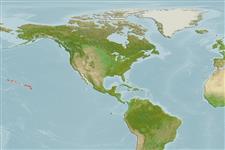>
Blenniiformes (Blennies) >
Blenniidae (Combtooth blennies) > Blenniinae
Etymology: Enchelyurus: Greek, enchelys, = eel + Greek, oura = tail (Ref. 45335).
Environment: milieu / climate zone / depth range / distribution range
Ecologie
marien rifbewoner. Tropical
Verspreiding
Landen | FAO regio's | Ecosystemen | Voorkomen | Point map | Introducties | Faunafri
Eastern Central Pacific: Hawaiian Islands.
Grootte / Gewicht / Leeftijd
Maturity: Lm ? range ? - ? cm
Max length : 2.9 cm SL mannelijk / geslacht onbekend; (Ref. 10697)
Adults are benthic in dead coral (Ref. 58302). Oviparous. Eggs are demersal and adhesive (Ref. 205), and are attached to the substrate via a filamentous, adhesive pad or pedestal (Ref. 94114). Larvae are planktonic, often found in shallow, coastal waters (Ref. 94114).
Levenscyclus en paargedrag
Maturities | Voortplanting | Spawnings | Egg(s) | Fecundities | Larven
Oviparous, distinct pairing (Ref. 205).
Springer, V.G., J.T. Williams and T.M. Orrell, 1991. Catalog of type specimens of recent fishes in the National Museum of Natural History, Smithsonian Institution, 2: Blenniidae. Smithson. Contrib. Zool. 519:28. (Ref. 10697)
Status op de Rode Lijst van het IUCN (Ref. 130435)
Gevaar voor de mens
Harmless
Gebruik door de mens
Tools
Speciale rapporten
Download XML
Internetbronnen
Estimates based on models
Preferred temperature (Ref.
123201): 24.3 - 26.4, mean 25.3 °C (based on 45 cells).
Fylogenetische diversiteitsindex (Ref.
82804): PD
50 = 0.5312 [Uniqueness, from 0.5 = low to 2.0 = high].
Bayesian length-weight: a=0.00562 (0.00258 - 0.01228), b=3.06 (2.87 - 3.25), in cm total length, based on LWR estimates for this (Sub)family-body shape (Ref.
93245).
Trofisch niveau (Ref.
69278): 3.2 ±0.4 se; based on size and trophs of closest relatives
Weerstandsvermogen (Ref.
120179): Hoog, minimale populatieverdubbelingstijd minder dan 15 maanden (Preliminary K or Fecundity.).
Fishing Vulnerability (Ref.
59153): Low vulnerability (10 of 100).
